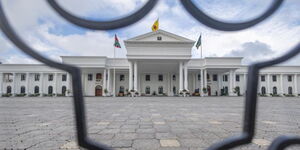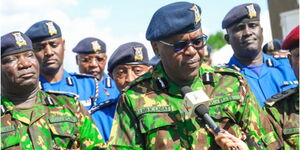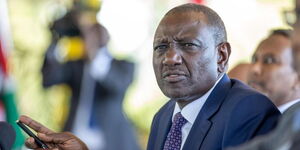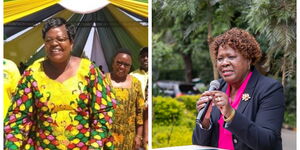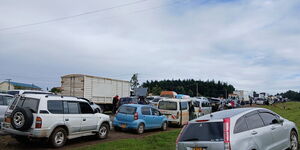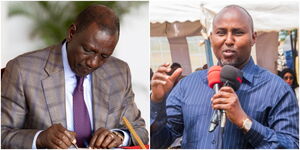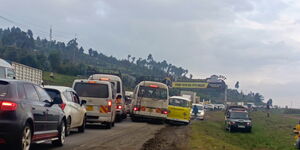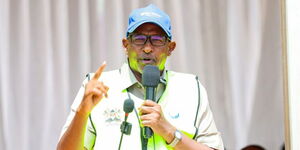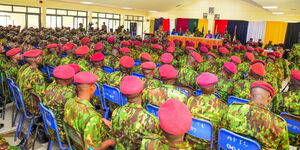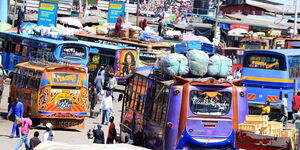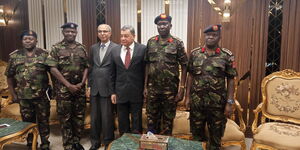The 2019 Population and Housing Census exercise was conducted on the night of August 24 and 25, 2019. The results were released by the Kenya National Bureau of Statistics (KNBS) on November 4, 2019.
The total number enumerated population was 47,564,296 with the total male population at 23,548,056 (49.5%) and that of females at 24,014, 716, making 50.5% of the population.
This meant that Kenya posted a population increase of nine million from the last count in 2009.
Total Population per counties.
Nairobi, Kiambu, Nakuru, Kakamega & Bungoma counties were the most populous counties. The least populous counties included Lamu, Isiolo, Samburu, Tana River & Taita Taveta.
Mombasa 1,208,333
Kwale 866,820
Kilifi 1,453,787
Tana River 315,943
Lamu 143,920
Taita/Taveta 340,671
Garissa 841,353
Waji 781,263
Mandera 867,457
Marsabit 459,785
Isiolo 268,002
Meru 1,545,714
Tharaka-Nithi 393,177
Embu 608,599
Kitui 1,136,187
Machakos 1,421,932
Makueni 987,653
Nyandarua 638,289
Nyeri 759,164
Kirinyaga 610,411
Murang'a 1,056,640
Kiambu 2,417,735
Turkana 926,976
West Pokot 621,241
Samburu 310,327
Trans Nzoia 990,341
Uasin Gishu 1,163,186
Elgeyo/Marakwet 454,480
Nandi 885,711
Baringo 666,763
Laikipia 518,560
Nakuru 2,162,202
Narok 1,157,873
Kajiado 1,117,840
Kericho 901,777
Bomet 875,689
Kakamega 1,867,579
Vihiga 590,013
Bungoma 1,670,570
Busia 893,681
Siaya 993,183
Kisumu 1,155,574
Homa Bay 1,131,950
Migori 1,116,436
Kisii 1,266,860
Nyamira 605,576
Nairobi City 4,397,073
Distribution of Population by Sex and County.
County Male Female Intersex
Mombasa 610,257 598,046 30
Kwale 425,121 441,681 18
Kilifi 704,089 749,673 25
Tana River 158,550 157,391 2
Lamu 76,103 67,813 4
Taita/Taveta 173,337 167,327 7
Garissa 458,975 382,344 34
Wajir 415,374 365,840 49
Mandera 434,976 432,444 37
Marsabit 243,548 216,219 18
Isiolo 139,510 128,483 9
Meru 767,698 777,975 41
Tharaka-Nithi 193,764 199,406 7
Embu 304,208 304,367 24
Kitui 549,003 587,151 33
Machakos . 710,707 711,191 34
Nyandarua 315,022 323,247 20
Nyeri 374,288 384,845 31
Kirinyaga 302,011 308,369 31
Murang'a 523,940 532,669 31
Kiambu 1,187,146 1,230,454 135
Turkana 478,087 448,868 21
West Pokot 307,013 314,213 15
Samburu 156,774 153,546 7
Trans Nzoia 489,107 501,206 28
Uasin Gishu 580,269 582,889 28
Elgeyo/Marakwet 227,317 227,151 12
Nandi 441,259 444,430 22
Baringo 336,322 330,428 13
Laikipia 259,440 259,102 18
Nakuru 1,077,272 1,084,835 95
Narok 579,042 578,805 26
Kajiado 557,098 560,704 38
Kericho 450,741 451,008 28
Bomet 434,287 441,379 23
Kakamega 897,133 970,406 40
Vihiga 283,678 306,323 12
Bungoma 812,146 858,389 35
Busia 426,252 467,401 28
Siaya 471,669 521,496 18
Kisumu 560,942 594,609 23
Homa Bay 539,560 592,367 23
Migori 536,187 580,214 35
Kisii 605,784 661,038 38
Nyamira 290,907 314,656 13
Nairobi City 2,192,452 2,204,376 245
Average Household Size by County
Data showed that counties in northern Kenya have the largest families in terms of household analysis.
The top counties in terms of household sizes are Mandera with 6.9 persons per family, Wajir at 6.1, Garissa 5.9, Marsabit 5.8, and Turkana 5.6.
West Pokot has five persons per house at 5.3, while Kwale is at 5.0. Nyeri, Kirinyaga and Kiambu are at 3.0. Murang'a and Embu at 3.3
Here is the full list
Mombasa 3.1, Kwale 5.0, Kilifi 4.8, Tana River 4.6, Lamu 3.7, Taita/Taveta 3.5, Garissa 5.9, Wajir 6.1, Mandera 6.9, Marsabit 5.8, Isiolo 4.6.
Meru 3.6, Tharaka-Nithi 3.6, Embu 3.3, Kitui 4.3, Machakos 3.5, Makueni 4.0, Nyandarua 3.5, Nyeri 3.0, Kirinyaga 3.0, Murang'a 3.3, Kiambu 3.0, Turkana 5.6, West Pokot 5.3, Samburu 4.7, Trans Nzoia 4.4, Uasin Gishu 3.8.
Elgeyo/Marakwet 4.5, Nandi 4.4, Baringo 4.7, Laikipia 3.4, Nakuru 3.5, Narok 4.8, Kajiado 3.5, Kericho 4.4, Bomet 4.7, Kakamega 4.3, Vihiga 4.1, Bungoma 4.6, Busia 4.5, Siaya 3.9, Kisumu 3.8, Homa Bay 4.3, Migori 4.6, Kisii 4.1, Nyamira 4.0, Nairobi 2.9.
Distribution of Population by Administrative Units
Enumerated Population
A total of 47,564,296 persons were enumerated during the census, comprising 23,548,056 males, 24,014,716 females and 1,524 intersex.
This represented an intercensal growth rate of 2.2 per cent compared to a growth of 2.9 per cent in the 2009 census.
Similarly, 32,732,596 were enumerated in rural areas and 14,831,700 in urban areas. Note that in this section, the intersex figures are too few to be distributed at sub national level and totals may therefore differ slightly from national aggregate
Distribution of Population by Age and Sex
Majority of the population are the youth.
The population pyramid for rural areas showed that a wide base concentrated among population aged below 15 years.
The population pyramid for urban areas indicated that majority of the population is concentrated between ages 20 and 34 among both sexes.
Most Populous Ethnic Communities
The Kikuyu community was the most populous in the country with a total of 8,148,668 people.
The Luhya community came in second place with a population of 6,823,842 followed by the Kalenjin community whose tally stands at 6,358,113 people.
Luo 5,066,966, Kamba 4,663,910, Somalis 2,780,502, Kisii 2,703,235, Mijikenda 2,488,691, Meru 2,488,691, Maasai 1,189,522, Konso 1299, El Molo 1104, Gosha 685 and Dahalo at 596.
Distribution of Population by Socio-Economic Characteristics
Education
A total of 17.8 million individuals reported that they were at school/learning institution; 11.6 million left school/learning institution after completion; 6.9 million left school/learning institution before completion; and 7.1 million had never been to school.
The data showed that 10.0 million people were attending primary school; 3.4 million were attending secondary school while 3.3 million were attending pre-primary school.
Those attending middle-level college/technical training education were about 500 thousand and those attending university education were 471 thousand.
Majority of respondents had attained primary education, followed by secondary education.
Persons with university education were 1.3 million.
Activity Status
The results showed that the economically active population was 22.3 million, comprising the working (19.7 million) and those seeking work (2.6 million). Females accounted for 50.2 per cent of the total working population.
The proportion of males in the urban areas that reported having worked was 50.4 per cent compared to 40.6 per cent of females.
A total of 18.9 million individuals were outside the labour force during the reference period. There were 10.1 million youth aged 18-34 years and 4.1 million youth aged 15-24 years in the labour force.
Housing Condition
The proportion of households owning the main dwelling unit they occupied was 61.3 per cent while those occupying rented/provided dwelling units were 38.7 per cent. Majority (93.9 per cent) of the owned dwelling units were constructed, 3.3 per cent were inherited and 2.8 per cent were purchased.
The 2019 KPHC data showed that 80.3 per cent of the households occupied dwelling units that had iron sheet as the main roofing material followed by concrete/cement at 8.2 per cent.
The dominant material used for wall construction was mud/cow dung at 27.5 per cent followed by stone with lime/cement at 16.5 per cent. Dwelling units
with concrete walls accounted for 16.3 per cent of the total.
The predominant floor material was concrete/cement accounting for 43.7 per cent followed by earth/sand floors at 30.0 per cent. More than a third (34.2 per cent) of households in the country relied on piped water as a source of drinking water. More than half (51.2 per cent) of households use covered pit latrine as a sanitation facility.
The most common mode of solid waste disposal was burning in the open, used by 27.1 per cent of the households. Firewood was the most commonly used type of cooking fuel reported by 55.1 per cent of the households followed by Liquefied Petroleum Gas (LPG) at 23.9 per cent. Slightly over half (50.4 per cent) of households reported using electricity mains as a source of lighting fuel followed by solar (19.3 per cent).
Agriculture
Total agricultural land operated by households stood at 10.3 million hectares, equivalent to 17.5 per cent of the total land area in the country.
Of the total enumerated households, 6.4 million were practicing agriculture. Households growing crops were 5.6 million while those practicing irrigation were 369,679. In total, 5.1 million households were engaged in maize cultivation followed by 3.6 million cultivating beans.
Livestock keeping was practiced by 4.7 million households while aquaculture and fishing activities were practiced by 29,325 and 109,640 households, respectively.
Disability
Questions on the six domains of disability (visual, hearing, mobility, cognition, selfcare and communication) were asked of persons aged five years and above while that of albinism was administered to everyone.
918,270 people aged 5 years and above had a disability. More females (523,883) than males (394,330) had disabilities. The common types of disability were mobility (385,417) followed by visual (333,520). A total of 9,729 persons had albinism.
Religious and Ethnic Affiliation
Majority (85.5 per cent) of the population are Christians with Protestants, Catholics and Evangelical churches accounting for 33.4, 20.6, and 20.4 per cent, respectively.
Muslims accounted for 11 per cent of the entire population. The five most populous ethnic affiliations were Kikuyu, Luhya, Kalenjin, Luo and Kamba while the five least populous were Dahalo, El Molo, Konso, Gosha and Wayyu.
Information and Communication Technology (ICT)
20,694,315 of individuals aged 3 years and above owned a mobile phone. More females (10,425,040) than males (10,268,651) owned a mobile phone. 22.6 per cent of individuals aged three years and above used internet while 10.4 per cent used a computer.
The proportion of population aged 15 years and above who searched and bought goods and services online was 4.3 per cent.
Ownership of Household Assets
A functional television set was the popular household asset owned by 40.7 per cent of households, with households in urban areas accounting for a larger share (62.5 per cent) compared to those in rural areas (26.9 per cent).
Approximately 9 per cent of households owned a motorcycle. A larger share of the rural households (10.8 per cent) than urban (6.7 per cent) owned a motor cycle.

